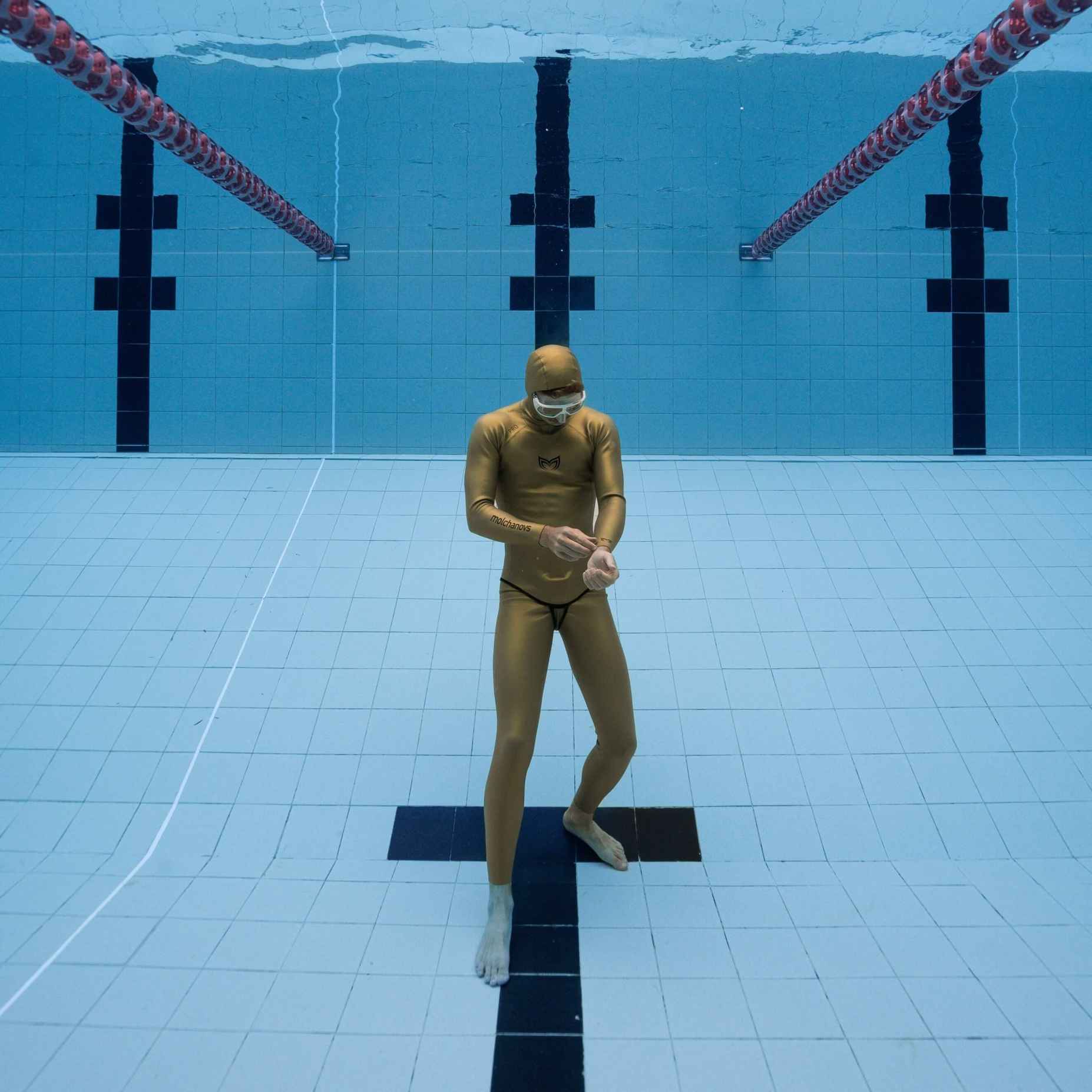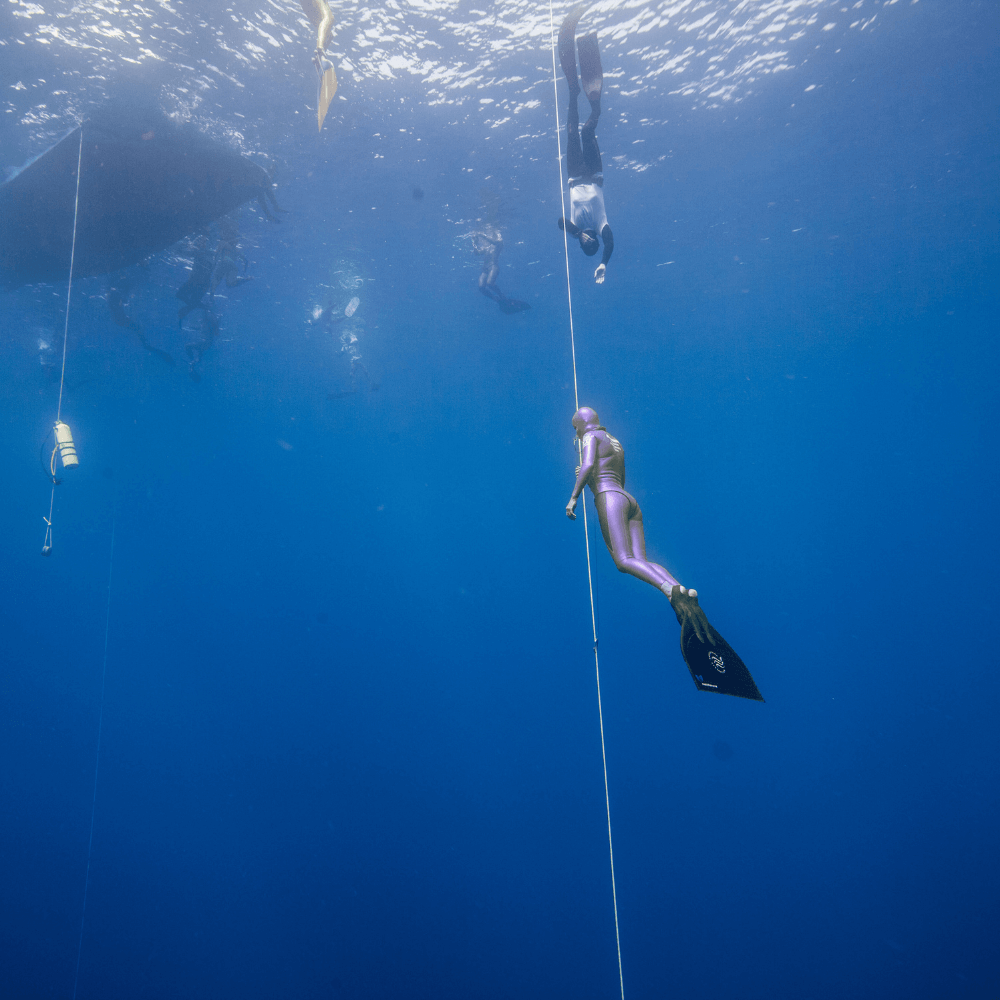PRO 프리다이빙 부이 설치 지침
새로운 PRO 프리다이빙 부이를 구매하신 것을 축하드립니다!
패키지 내용
- 부표
- 인플레이터 튜브
- 밸브 키
- 에어 펌프 어댑터
- 깃발
- 수리 키트
- 아교
- 패치 소재
PRO 프리다이빙 부이에 공기를 넣는 방법
1. 부표를 준비하세요
부표를 평평한 표면에 완전히 펼칩니다.
2. 버튼을 눌러 밸브 위치를 설정하세요.
- 아래 위치 : 밸브가 열려 있습니다. 즉, 공기가 부표 안으로 자유롭게 드나들 수 있습니다. 이 밸브 위치는 부표의 공기를 빠르게 빼는 데 사용됩니다.
- 위쪽 위치 : 밸브가 닫힙니다. 즉, 공기가 부표 안으로 들어갈 수는 있지만 빠져나갈 수는 없습니다. 이 위치는 부표를 부풀려 사용하는 데 사용됩니다.
3. 인플레이션에 대비하세요
밸브가 "아래쪽" 위치에 있는지 확인한 후 다음을 수행할 수 있습니다.
- 수동 팽창을 위해 인플레이터 튜브를 부착하거나
- 자동 펌프와 함께 어댑터를 사용하세요
4. 부표를 부풀려주세요
부표 밸브 근처에 표시된 권장 압력(5 psi / 0.3 bar)까지 공기를 주입하세요. 과충전을 방지하기 위해 펌프 대신 입으로 부표를 부풀리는 것을 권장합니다.
5. 플래그를 부착하세요
지정된 부착 지점에 깃발을 단단히 고정하세요.
이제 PRO 프리다이빙 부이 2를 다이빙에 설치할 준비가 되었습니다!
밸브를 제거해야 하는 경우(누수 확인, 밸브에 묻은 이물질 청소 등), 제공된 밸브 키를 사용하여 밸브를 제거하고 부표에 다시 조여 고정하세요.
다이빙 준비
1. 장비를 검사하세요
다이빙을 하기 전에 부표, 다이빙 라인, D링을 검사하여 시각적으로 손상이 있는지 확인하세요.
2. 로프 시스템 설정
부표 바닥의 D-링(아래 "프리다이빙에 권장되는 카라비너" 참조)에 있는 카라비너를 통해 로프를 삽입합니다. 풀리 시스템을 사용하는 경우(모든 다이빙에 강력히 권장), 풀리 시스템을 D-링에 연결된 카라비너에 직접 연결할 수 있습니다.
3. 바닥 무게를 부착합니다.
적절한 매듭(예: 물 매듭)이나 부착된 카라비너를 사용하여 바닥 무게를 다이빙 라인에 연결합니다.
4. 목표 깊이를 설정하세요
풀리 시스템 없이 다이빙하는 경우, 원하는 수심 표시 부분에 다이빙 로프를 클로브 히치로 고정하세요. 두 번째 카라비너에 남은 로프를 사용하여 또 다른 클로브 히치를 고정하세요.
5. 배포 준비
부표에서 줄을 꺼내세요.
6. 다이빙 장소를 확인하고 배치하세요.
다이빙 장소를 주의 깊게 살펴보세요. 물속에 다이버가 있다면, 그들이 헤엄쳐 나갈 때까지 기다렸다가 바닥에 무게추가 달린 다이빙 로프를 천천히 풀어주세요.
중요 참고: 풀리 시스템을 사용하지 않는 경우, 로프를 내릴 때 하단 웨이트가 로프의 어떤 부분과도 엉키지 않도록 주의하십시오. 로프가 제대로 꼬여 있다면 하단 웨이트가 가라앉으면서 로프가 자동으로 풀릴 것입니다. 로프가 완전히 풀리면 클로브 히치가 원하는 깊이에서 로프를 고정합니다.
절대로 혼자 다이빙하지 마세요! 반드시 자격증을 소지한 친구와 함께 다이빙하세요!
중요 안전 수칙
사용 전:
- 다이빙하기 전에 항상 장비를 점검하고 부표를 정기적으로 검사하여 손상 징후가 없는지 확인하십시오.
- 부표를 접을 때 내부에 이물질이 있는지 확인하세요.
- 부표 내부에 금속이나 기타 재질로 된 날카로운 물건을 넣지 마십시오. 부표가 손상될 수 있습니다.
사용 중:
- 프리다이빙 중 비상시에 공기를 추가하기 위해 부표의 메쉬 포켓에 인플레이터 튜브를 보관하십시오.
- 수면 로프는 항상 D링에 연결하고, 부표 손잡이에는 연결하지 마십시오. 안전(또는 백업) 카라비너는 부표의 지정된 하중 지점인 D링에도 연결하여 도르래 고장 시 로프를 안전하게 고정해야 합니다.
- 과도한 팽창을 방지하기 위해 펌프 대신 입을 사용하여 부표를 팽창시키는 것이 좋습니다.
- 부표에 표시된 5 psi/0.3 bar를 초과하여 공기를 넣지 마십시오. Molchanovs는 과도한 공기 주입으로 인한 성능 문제나 손상에 대해 책임을 지지 않습니다.
사용 및 보관 후:
- 사용 후에는 항상 깨끗한 물로 부표를 헹구십시오.
- 부표를 직사광선, 더운 차량 안 또는 열원 근처에 두거나 보관하지 마십시오.
- 80°C(176°F) 이상의 온도에 장시간 노출되지 않도록 하십시오.
- 농축된 산이나 탄화수소계 화학물질에 노출시키지 마십시오.
- 장기간 보관하려면 완전히 건조된 부표를 부분적으로 또는 완전히 수축시키고 중앙 난방에서 멀리 떨어진 서늘하고 어두운 곳에 보관하십시오.
유지:
- 밸브에서 공기가 누출되는 경우 밸브 키를 사용하여 조이십시오. 최소한 1년에 한 번은 밸브를 조이는 것이 좋습니다.
부표 수리
PRO 프리다이빙 부표는 내구성이 뛰어난 고품질 PVC로 제작되었습니다. PVC는 팽창식 보트에 사용하는 소재와 동일하여 찢어짐과 펑크에 매우 강합니다.
부표를 수리해야 하는 드문 경우, 다음의 간단한 단계를 따르세요.
1. 손상 부위 찾기
- 부표를 부풀려라
- 표면에 비눗물을 바르세요
- 공기가 빠져나가는 것을 나타내는 거품을 찾으세요
- 구멍의 위치를 표시하세요
2. 수리 준비
- 부표를 완전히 수축시키세요
- 구멍을 덮을 만큼 큰 PVC 패치를 잘라냅니다.
- 부표에 패치를 붙이고 그 주위에 종이 테이프를 붙여 부표의 나머지 부분을 접착제 얼룩으로부터 보호합니다.
3. 표면 청소 및 준비
- 아세톤을 사용하여 손상된 부위의 기름을 제거합니다.
- 완전히 건조시키세요
4. 접착제를 바르세요
- 패치와 부표 표면 모두에 PVC 접착제를 바릅니다.
- 약 10분 정도 접착제를 말려주세요.
- 헤어 드라이어를 사용하여 접착면과 패치를 1분 이내로 고르게 가열하고 열을 30~40°C(86~104°F)로 유지하여 접착제를 재활성화합니다.
5. 패치를 부착합니다
- 패치를 구멍 위에 조심스럽게 놓으세요
- 좋은 접촉을 위해 단단히 누르세요
- 패치 위에 무게추를 올려 놓으세요
6. 경화되도록 두십시오
- 24시간 동안 그대로 두십시오( 중요 참고 사항: 부표가 완전히 마르기 전에 부풀리거나 사용하지 마십시오)
- 무게추와 보호테이프를 제거하세요
- 잉여 접착제를 깨끗이 닦아내세요
7. 수리를 테스트하세요
- 부표를 다시 부풀려라
- 남아 있는 공기 누출이 있는지 확인하세요
이제 다음 세션을 위해 부표를 준비할 수 있습니다!



